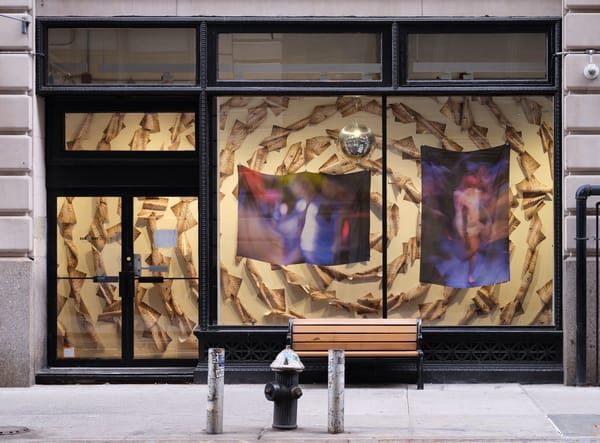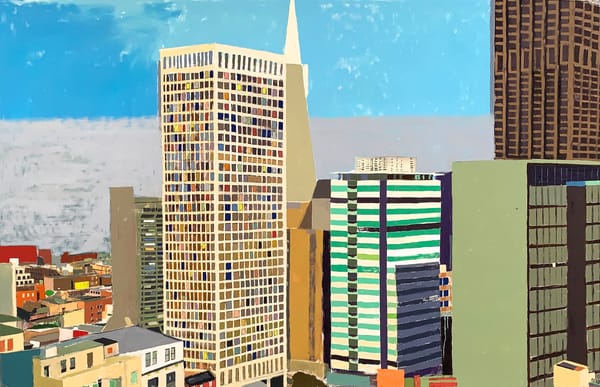A Rewritten History of the Taiwanese-Japanese Sugar Trade
There Is Another Capital Beneath the Waves ruminates on commerce, colonization, and conflict between manipulative forces that fuel the engine of history.

TAIPEI — There Is Another Capital Beneath the Waves at the Hong Gah Museum guides its audiences assertively through its three galleries. The exhibition, a collaboration between artists Chia-Wei Hsu, Ting-Tong Chang, and Hsien-Yu Cheng, comprises two films that unpack the braided affairs of the Taiwanese and Japanese sugar industries, “Crystal Seedling” and the title work. The film installations ruminate on commerce, colonization, and conflict between manipulative forces that fuel the engine of history, drawing the curtain on one act and revealing the next, like the forward march of time.
The production begins with a Japanese colonial building. Its facade is painted across folding screens propped on the floor and panels suspended from the ceiling of the museum’s first gallery. Viewed from the entrance, it looks authoritative and sturdy. However, reaching the back of the room, it appears fragmented, like an arrested explosion. The works in the exhibition are littered with such stages, where the floor beneath one history collapses into the next.
Huwei — the Taiwanese town at the heart of Japan’s colonial sugar empire, nearly destroyed by US armed forces in WWII — is the backdrop of “Crystal Seedling.” A performer coaxes music from the historic Huwei Sugar Factory’s equipment with drumsticks and a bow. The discordant crooning of rusty machines backs a spectacle of Taiwanese glove puppetry, staged in the fields of Yulin County, where sugarcane still grows. The story is a retelling of “Kurama Tengu,” a staple of the era when the Japanification of Taiwanese arts was enforced by government mandate. In this version, the rogue samurai rescues the town's workers from the scheming of murderous and corrupt officials. While some puppets wield katana, others follow the action with camcorders and boom mics.

The puppet is the principal actor of both films. The multichannel finale, “There Is Another Capital Beneath the Waves,” opens to a Bunraku puppet, veiled in white, being marched around the Kanmon Seito Co. factory in Moji-ku, another historic node in the network of Japanese sugar manufacturing. Digital motion sensors are strapped to its wooden limbs, and a rendering of a puppet-like, traditionally costumed figure on an adjacent screen moves in step. The figure morphs into a noblewoman in a shining red kimono, perhaps Nii no Ama, from the 14th-century Japanese legend “The Tale of the Heike,” which chronicles the clash between the Taira and Minamoto clans, vying for dominion over Japan. Indeed, the film is named for the words the character whispered to her newborn grandson as she saw history turn against them, choosing a fate of drowning rather than defeat. But who was pulling her strings as she leapt into the ocean, infant emperor in her arms? Golden horns sprout from the digital puppet’s head like antennae, the historical figure corrupted and her history open to new interpretation. A human dancer in a VR headset usurps control of the puppet as she slips beneath a swell of digital ocean. Is history itself a virtual reality, the work asks, another stage where manipulation is open source?
The dancer, peering through the VR headset, twirls the puppet among the wreckage of a luxury ocean liner that prowled the waters between Japan and Taiwan in the heyday of empire. This seizure of puppet strings resonates throughout the exhibition, pointing to the manipulations and machinations that drive history. Yet rather than a revision of colonial history, the show is a reconsideration of history itself, and the possibility of tweaking the strings that move it forward.



There Is Another Capital Beneath the Waves continues at the Hong Gah Museum (166 Daye Road, Beitou District, Taipei City, Taiwan) through June 30. The exhibition was organized by Chew’s Culture Foundation, Hong-Gah Museum in collaboration with Taiwan Contemporary Culture Lab (C-LAB).





